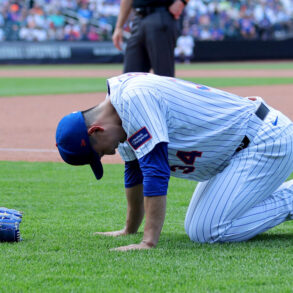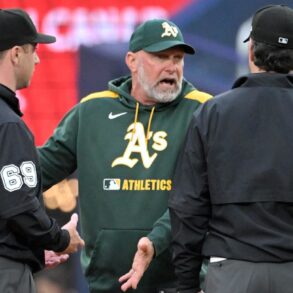
On almost any given night, from late March to early November, a baseball fan can turn on the television and find a game to watch. The players, managers and coaches of Major League Baseball can become a presence in the viewer’s life, a collection of protagonists and antagonists able to be followed as spring turns to summer turns to fall. Because you can see these people all the time, you can understand their lives.
Advertisement
Yet to hear players tell it, there is still a sizable gap between the public’s perception of the profession and the lived experience of the players. As part of The Athletic’s annual MLB Player Poll, our writers offered the participants a chance to correct the record:
What is the biggest misconception about the lifestyle of a baseball player?
More than 130 players gave us their thoughts. The responses mostly fit into a few categories, with answers centered around the grind of the 162-game season, the extensive time commitment, the lack of free time with friends and family, and the economic realities of players on the fringes. Many respondents acknowledged the remarkable privilege of playing professional sports while still taking a moment to vent.
“Our life is awesome, but it’s not as easy as people think it is,” one National League pitcher said. “I don’t know if fans realize that when we say we spend more time with our teammates than our families, we’re not exaggerating. It’s not even close. That’s why I say if you want to be a good dad, a good husband, it’s not easy.”
Added another National League pitcher, “I haven’t seen my mom on her birthday in 17 years. Little things like that that matter to me. People are like, ‘Yeah, but you’re getting paid, you’re getting treated great.’ . . . I’ve missed so many things for so many years, even before pro ball. Like, I couldn’t go to my prom because I had a baseball tourney, you know? It’s just little sacrifices you make over the years that you never get back.”
The answers revealed one connection between the average baseball player and the average baseball consumer: traveling can be miserable. No, players don’t have to worry about missing a connecting flight or checking the hotel room for bed bugs. But even with chartered planes and top-shelf hotels, players said, putting your life in a suitcase several times a month can be exhausting.
Advertisement
“You’re packing up every single week,” one National League hitter said. “You’re either going home or on the road. You pretty much only spend one week in one spot.”
Added an American League pitcher, “People don’t fully understand the travel. Getting in late at night and going on short rest. Playing at night. Playing 162 games. I don’t think people fully see everything that goes into that, and how it affects your body towards the middle to the end of the year.”
Added a National League pitcher, “I don’t know if people realize how hectic the travel is and how exhausting that is. There’s so little downtime.”
The proliferation of data and the importance of advanced scouting has led to longer days at the ballpark. Rebuilding teams devote those hours to helping players develop at the big-league level. Contending teams use the time to share strategies to win that night.
Which means . . .
“People ask what time I get here, and I tell them 1 p.m. — they’re shocked,” one National League pitcher said.
And that guy might be getting to the park a tad too late.
“We get here at noon,” one American League pitcher said. “We practice before. Everyone has his own routine: weightlifting, throwing. We get to the field way before first pitch.”
Added a National League position player, “They think we just show up and play the game. But they don’t really see the work that goes in the hours before: going over scouting reports, hitters’ meetings, base running meetings and doing your full warm-up routine. Go to BP, chill for a second and then get it going again to play a game. After the game, get a lift in, talk to the media, go get dinner, see your family. It’s a full-day thing.”
This could explain, one American League hitter suggested, why it might not be easy to snag an autograph during batting practice. “People think we are arrogant with our time, but our time is very limited during (batting) practice,” the player said.
Advertisement
Because the day begins long before the television broadcast starts, one National League pitcher said, that could explain why fans question a team’s effort during a losing streak. “Sometimes when it goes bad, they don’t have the empathy because they don’t see the work we’re putting in behind the scenes,” the player said.
This is the labor required to make routine plays look routine. And even then, several players said, the routine can be difficult to execute. One National League pitcher harrumphed about those who think “that the game’s f—ing easy. Everyone complains about what might seem like the simplest tasks, but in our world, it’s one of the hardest things to do in sports.”
The schedule makes activity away from the ballpark less adventurous. “The lifestyle of ballplayers has changed drastically over the last 20 years,” one American League pitcher said. “People aren’t going out. There’s not a nightlife. People think players go out and do whatever they want. That doesn’t happen anymore. But apparently back in the day, it did.”
Added another American League pitcher, “People are like, ‘Dude, what’s it like to be in Seattle for three days?’ I got one lunch and one breakfast. You don’t have time. I don’t go to the beach.”
Not even family members are immune to misunderstanding. “I had family that was in town one time,” one National League hitter said. “We had a game at 7 p.m. and they said, ‘You want to get dinner at 5?’ Yeah, I can’t do that.”
The strain that baseball puts on relationships with friends and family also came up often among our respondents. The schedule forces players to miss milestones. “Can’t go to any weddings ever,” one pitcher said.
It strains the connections with friends. “I haven’t had a summer since I was eight or nine,” one American League hitter said.
Advertisement
It puts stress on your partner and children. “When you have kids and you’re away from home half the month, going city to city, it’s just not as glamorous as people think,” another National League pitcher said.
The time at the top can be fleeting. “We’re all people, just like everybody else, trying to make a living,” one American League pitcher said. “Not every single player on the baseball field has superstar status. Most of the guys up here and grinding just to try to stay afloat. I mean, we’re all having the time of our lives. But at the same time, most players are grinding their butt off to stay there. Most careers aren’t as long as people think. I’ve talked to guys who got two or three years up here and they wish they’d been able to enjoy it more. But they were grinding so hard just to stay at this level.”
Which brings us to . . . the money.
The major-league minimum salary is $760,000 in 2025, and it will rise to $780,000 in 2026, the final year of the current collective bargaining agreement. Suffice it to say, that is good work if you can get it. But as the players have already detailed, to reach this summit requires sacrifices. “People see the contracts we sign, or even the major-league minimum and think we’re set for life,” one National League hitter said. “You don’t know what goes into it.”
And achieving the right to earn millions through arbitration and then free agency is a privilege that most players cannot reach.
“Baseball shows the top one percent, and those are the people that are marketed,” one American League pitcher said. “But no one really knows about the guy who has parts of five years in the show but only 20-something days total, the fringe guys their entire career. Yes, they’re making good money, but by no means are they wealthy. There’s probably a misnomer (that) if you play baseball, you’re incredibly rich.”
Added another American League pitcher, “Yes, the living is good. Yes, we make good money, some way more than others. But the logistics behind everything, moving your family, paying for two to three mortgages and the stress it causes some families. You’re always on the move and until you’re on a guaranteed contract, you’re kind of living out of a suitcase. There’s a lot of logistics and not knowing that I don’t think people understand.”
Advertisement
Added one National League pitcher, “The biggest misconception is that people look at you like you’re a multi-multi-millionaire because you’re in the big leagues. Don’t get me wrong, we make good money, but people ask me how many homes I’ve got. It’s not like that in your first year — you’re making the minimum, which is good money, but you’re not like crazy rich.”
Some of these gripes may not be well-received. It may be hard to find pity for the American League hitter who groused that “nobody realizes we have to pay big-time taxes on our salaries.” It may be difficult to empathize with the fellow complaining about paying three different mortgages — an offseason home, a spring-training property and a regular-season home. But these are the realities that some players face, ones that they believe the public does not recognize.
“I don’t think people understand the logistics, especially if you have a family, of trying to organize moving, living in three different places, traveling with kids, making sure they have cribs,” one American League pitcher said. “The stress just mounts. We just moved to a city that neither of us has ever been to. Money certainly helps, but it doesn’t solve all of those problems.”
One National League hitter found a pithy way to summarize the knowledge gap between the players and the public.
“I don’t really know,” the player said, “what people think about us.”
Editor’s note: Some player quotes included in this story have been lightly edited for length and clarity.
(Illustration: Dan Goldfarb / The Athletic; Photo: iStock)
This post was originally published on this site be sure to check out more of their content.








